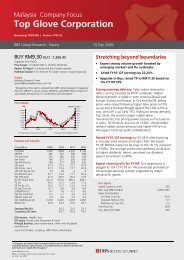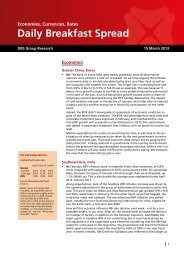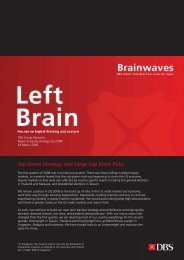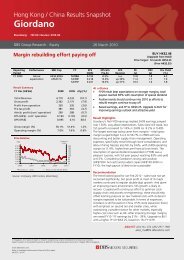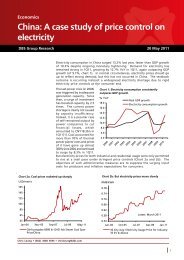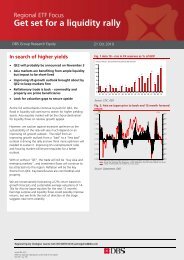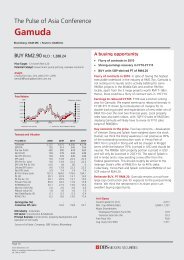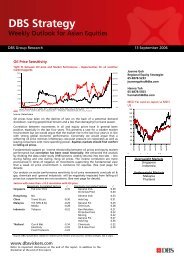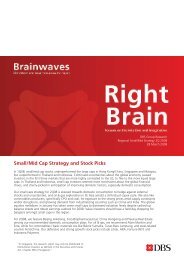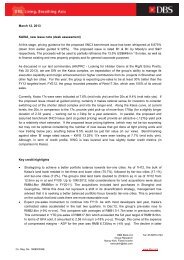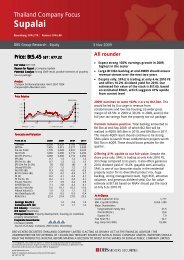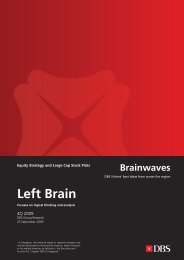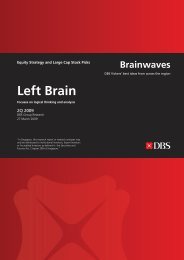Economics Markets Strategy - the DBS Vickers Securities Equities ...
Economics Markets Strategy - the DBS Vickers Securities Equities ...
Economics Markets Strategy - the DBS Vickers Securities Equities ...
You also want an ePaper? Increase the reach of your titles
YUMPU automatically turns print PDFs into web optimized ePapers that Google loves.
<strong>Economics</strong> – <strong>Markets</strong> – <strong>Strategy</strong><br />
Currencies<br />
Singapore dollar – a higher USD/SGD is not inconsistent with a rising SGD NEER<br />
Based on our expectations for <strong>the</strong> USD to recover some lost ground, as well as<br />
continued weakness in Asian currencies, we now see upside risks for USD/SGD to<br />
rise towards 1.44 in <strong>the</strong> next 6-12 months.<br />
Over <strong>the</strong> past two years, <strong>the</strong> market has become accustomed to associating a<br />
lower USD/SGD with a strong SGD NEER (nominal effective exchange rate) policy.<br />
More so after USD/SGD increased <strong>the</strong> pace of its fall with each tightening at its<br />
last two Monetary Authority of Singapore (MAS) policy reviews 1/ . We have no<br />
problem with this association as long as <strong>the</strong> USD is depreciating against <strong>the</strong> SGD<br />
NEER’s trade-weighted basket of currencies.<br />
At this point, we would also like to remind readers that USD/SGD can head up<br />
despite a strong SGD NEER policy. For example, USD/SGD rose from 1.6327 to<br />
1.6627 in 2005, even after MAS shifted in Apr 2004 to a policy of appreciating<br />
<strong>the</strong> SGD NEER at a modest and gradual pace. During 2005, after USD/SGD bottomed<br />
at 1.6180 on Mar 10, it surged 5.3% to 1.7051 on Nov 14 before resuming its<br />
downtrend. The reason for this was simple. The USD was firm because <strong>the</strong> US<br />
was in <strong>the</strong> process of raising interest rates from 1.00% to 5.25%. This led to a<br />
broad-based USD recovery against both major currencies and Asian currencies.<br />
Like today, record high oil prices became a problem for some Asian economies,<br />
and forcing neighbouring countries like Indonesia to cut fuel subsidies.<br />
Currently, we see upside risks in USD/SGD coming mainly from major currencies.<br />
Since <strong>the</strong> outbreak of <strong>the</strong> US subprime/credit crisis in Jul 2007, <strong>the</strong> SGD has<br />
broken ranks with Asian currencies and closely followed <strong>the</strong> major currencies<br />
stronger. To facilitate this dichotomous behaviour, <strong>the</strong> MAS had to re-center its<br />
SGD NEER policy band at its policy review in April.<br />
USD/SGD<br />
forecast, eop<br />
Latest Prev<br />
Close 1.37 1.38<br />
2Q08 1.37 1.41<br />
3Q08 1.38 1.38<br />
4Q08 1.40 1.35<br />
1Q09 1.42 1.38<br />
2Q09 1.44 1.37<br />
3Q09 1.42 1.37<br />
4Q09 1.40 1.36<br />
3M Sibor<br />
forecast, eop<br />
Latest Prev<br />
Close 1.44 1.31<br />
2Q08 1.16 1.13<br />
3Q08 1.31 1.14<br />
4Q08 1.52 1.13<br />
1Q09 1.94 1.49<br />
2Q09 2.31 2.79<br />
3Q09 2.67 2.30<br />
4Q09 2.64 2.60<br />
Latest close on Jun 11<br />
Prev close on Mar 12<br />
This goes some way to explain why <strong>the</strong> MYR/SGD cross rate has weakened below<br />
its 0425-0.452 range, while <strong>the</strong> EUR/SGD cross rate appears to be establishing<br />
stable 2.10-2.18 trading range. This should not come as a surprise since Malaysia<br />
is still Singapore’s largest trading partner in Asia, while Eurozone has overtaken<br />
<strong>the</strong> US as <strong>the</strong> largest amongst <strong>the</strong> developed economies.<br />
Unless <strong>the</strong> MAS is seeking to re-center its band before its next policy review in<br />
October, we urge readers to pay close attention to EUR/USD, whose fall is likely<br />
to push up USD/SGD.<br />
1/<br />
In Oct 2007, <strong>the</strong> MAS “slightly” increased <strong>the</strong> appreciation pace of <strong>the</strong> SGD NEER policy band.<br />
This was followed by a re-centering of <strong>the</strong> SGD NEER band in Apr 2008. Both tightening were<br />
aimed at reining in inflation, which rose to a 26-year high of 7.5% in Apr08.<br />
SGD has been tracking major currencies since<br />
<strong>the</strong> start of <strong>the</strong> US crisis<br />
104 Performance of USD vs currencies<br />
Indexed: 15 Jul 07 = 100<br />
102<br />
100<br />
98<br />
96<br />
94<br />
92<br />
90<br />
88<br />
86<br />
Major currencies<br />
(implied by DXY index)<br />
Asian currencies<br />
(implied by ADXY index)<br />
SGD<br />
Jul-07 Oct-07 Jan-08 Apr-08<br />
USD/SGD & SGD NEER can diverge occasionally<br />
108<br />
106<br />
104<br />
102<br />
100<br />
98<br />
96<br />
94<br />
2005 US<br />
rate hike<br />
cycle<br />
Re-centering<br />
Appreciation<br />
pace increased<br />
USD/SGD (rhs)<br />
Start of strong SGD policy<br />
Jan-04 Jan-05 Jan-06 Jan-07 Jan-08<br />
SGD<br />
NEER<br />
(lhs)<br />
1.75<br />
1.70<br />
1.65<br />
1.60<br />
1.55<br />
1.50<br />
1.45<br />
1.40<br />
1.35<br />
1.30<br />
35



